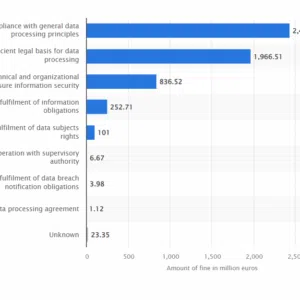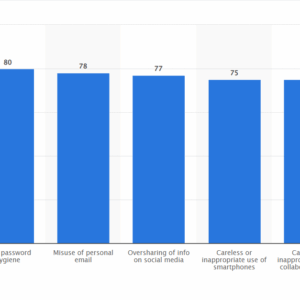


Customer effort score surveys are a great way to find out how easy it is for a customer to do business with your company.
But just like a lot of survey instruments, if they get into the wrong hands, customer effort score surveys can lead to security issues.
We’ll talk about what you can do to mitigate this problem using easy-to-employ techniques that you can deploy straightaway. But we’ll start with a definition so we can all be sure what we’re talking about.
What is a customer effort score survey?
In the competitive online environment, you can’t simply adhere to the mantra “If you build it, they will come” and leave it at that.
The trouble is that they might come, decide that it’s full of snags and niggles, then go to one of your primary competitors for what they need.
What’s needed here is a way of assessing how easy customers are finding it to get what they need. This is what a customer effort score calculation tells you.
It’s a way for a customer to record their perceptions of how much trouble it was to interact with your organization in the course of trying to fulfill their requirements. The business can then work on these actionable insights to make an effortless experience more than just an ambition.
The great thing about customer effort score surveys is that they can be used in a variety of applications, from websites and socials to counter service and IVR systems.
In all of these use cases, what’s measured boils down to the same thing: good old-fashioned customer satisfaction as a result of positive customer encounters.
Types of customer effort score survey
What form might your customer feedback survey take?
A very common one is the smiley face or emoji scale method, in which customers rate the experience of interacting with the site with an expression drawn from a scale.
This is a great one to use if you don’t want to keep your customer for long. It’s quick and effective, and you get an emotive response.
For deeper insights, it’s often a good idea to use Likert scales. These give the customer the chance to rate several different aspects of a customer journey using a 1-5 scale, covering a range of reactions.
You may also include some open-ended questions that give the customer the chance to expand at length. All of these can give very useful customer feedback, with positive responses, neutral responses, and negative responses all being hugely useful.
The security issue
All organizations and practices have their own data protection issues (This is why there are different kinds and levels of System and Organizational Controls, such as SOC 2 type 2 vs. type 1).
A customer satisfaction survey can be especially sensitive, no matter which survey method you use. All data collection techniques should carry with them an awareness and practice of data protection. This is because of two factors.
Firstly, it’s the right thing to do. Secondly, any such information given to you by a customer through a survey is subject to a data protection statutory framework.
If you have any customers in Europe, this is covered by the General Data Protection Regulation (GDPR). In the US, there are a number of relevant laws, including the California Consumer Privacy Act (CCPA).
If you do anything that goes against such legislation, you’ll be facing a stiff fine. This can be a huge deal, as this chart of the largest fine amounts shows:
Image sourced from statista.com
So, you have reason to treat data security as a paramount concern. Let’s see how you can do this.
Customer effort score survey security tips
There are numerous methods you can put in place to keep your customer effort score surveys on the right side of the data security line.
1. Keep it minimal
A lot of data protection legislation states that you must only collect the data you need.
So, stick to the point. If you’re doing, say, customer loyalty programs, you need contact details and purchase history. But if you simply want to know how easy it was to navigate your site, just ask about that.
Moreover, there should be a sentence or two describing the scope of the inquiry and what the data will be used for. Communicate clearly with the customer and stick to what you’ve written. It’s all part of the trust that’s so important in user experience and commerce.
One final point here is that if your survey can be anonymous, that’s even better. If the worst happens and a data breach occurs, only scores on a scale will be at risk.
2. Encryption is vital
Cybercrime is rife, so it’s fundamentally important for you to adopt robust encryption processes. When considering encryption, it’s vital to think about the journey that the survey question data takes.
There’s the collection stage, storage stage, and processing stage. There’s also the transit stage between sites and APIs. (What’s an API? This is the software that allows applications and web services to communicate with one another).
At each and every one of these junctures, data can be vulnerable to exposure to illegitimate scrutiny. So, be thorough.
What kind of encryption are we talking about? Well, HTTPS is the industry standard, and customers know that it’s secure. You can use a range of other methods, such as Advanced Encryption Standards (AES) and Transport Layer Security (TLS).
Different methods tend to be used for data at different stages of its journey, so a combined approach is best.
Encryption needs constant improvement. This is because cybercriminals are continually upping their game. So, return to the issue regularly. Try to sniff out the weak points that might form the best attack vectors. Test the structure repeatedly and sign up for regular automatic encryption updates.
3. Ask for consent
Another key element of any data protection procedure is to explicitly ask for customer consent before going ahead with data collection. It’s a vital stopping point where the customer has the chance of opting out before things go any further.
Why is this important? Because it’s conceivable that a customer may drift along from site to site and end up committing their data to a survey without fully realizing what they’ve done.
For these times, it’s imperative that there’s a roadblock of sorts, where a customer comes face-to-face with what’s about to happen and gives consent or not.
One of the outcomes of this is that there can be no subsequent confusion over what then takes place. Such confusion can lead to litigation, so it’s important to eradicate it.
Besides all this, it’s polite to ask. Bad customer service assumes, while good customer service asks for clear consent to store customer details.
4. Password protocol
This is one for staff who are processing the data gathered. The password entry stage is a key security juncture. Easy-to-break passwords are responsible for a huge number of data breaches.
This chart shows that poor password hygiene was found to be the most common mistake that led to cyber incidents.
Image sourced from statista.com
So, insist on your staff using robust passwords that follow a secure pattern. Give them the responsibility to change them frequently, disallowing any repeated use of prior passwords. Password compliance is absolutely essential if you’re going to maintain a decent level of data protection.
Consider giving staff a good password manager facility. One master password is then all that’s required for a team member to remember in order to access a range of passwords for anything they need to access.
5. Cover up
Let’s return to customers for this last one. Some information can be especially sensitive, so it’s a good idea to obscure it when entry takes place.
What kind of information? Contact details, payment details, social security numbers, and addresses are all good examples of the kind of thing that can be especially damaging in the wrong hands.
You might be thinking, “It doesn’t really apply to me as I don’t deal that much with customers. I’m in the B2B prospecting game, so the chances are that sensitive information will not be quite so much of an issue.”
However, don’t get fooled into thinking it won’t crop up at all. In the wrong hands, even information such as a work email can combine with other data to make quite a potent attack route.
So, whatever line of work you’re in, if your customer effort score questions involve anything with a degree of sensitivity, it makes sense not to have them appear on screen at all. Replace with asterisks so that all that key data gets protection from prying eyes.
Customer effort score survey security: It’s in the mix
Great data security depends on the deployment of a range of practices. This is because survey response data goes through a series of steps, with vulnerabilities possible anywhere along its journey.
Consider the respondent’s actions, the passage and storage of data, and the behavior of your data processing staff. If you can cover all these stages and use recommended procedures, such as encryption, you’ll be on the road to customer effort score data security.
FAQs
Why is it important to create a secure customer effort survey?
As customers may provide sensitive or personal information within their responses, it’s vital that you create a secure customer effort survey. This will ensure that you are able to guard against unauthorized access, data leaks, or the misuse of your customer’s data.
On top of this, by guaranteeing the security of your customer’s data, you will encourage participation and honest feedback as customers feel confident that their responses will be handled safely and responsibly.
What are the benefits of using customer effort score surveys?
Customer effort score surveys give actionable insights into how you can create smoother customer experiences and boost customer loyalty to achieve a higher rate of customer retention.
Is a customer effort score survey the same as a customer satisfaction survey?
While a customer satisfaction survey and a customer effort score survey both provide customer insights through the use of follow-up questions, they’re not the same.
A customer satisfaction survey measures overall customer satisfaction whereas a customer effort survey provides an insight into how much effort customers had to go to to get what they wanted from a business.
Regardless of which type of customer survey you use, it will provide you with invaluable customer insights even if you receive negative feedback as that will show you what areas need to be improved.
Originally published May 22, 2025
Source link





No Comment! Be the first one.